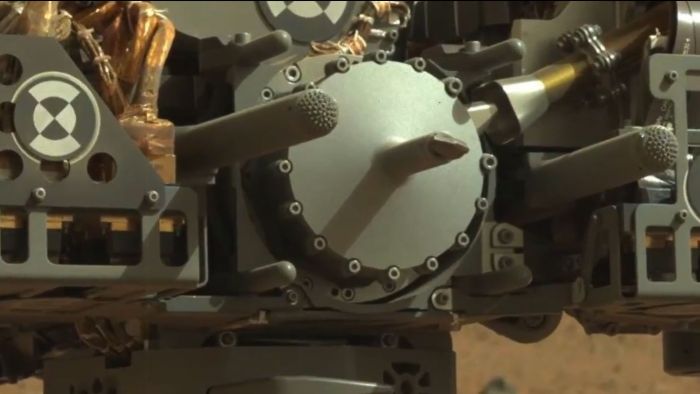 Over the course of the last week Curiosity has been busy. Sols 39 through 41 (September 14th through 17th) were driving days in which the rover continued on its traverse towards the area dubbed Glenelg. On Sol 39, Curiosity logged 22 metres (72 feet), and covered a further 37 metres (121 feet) on Sol 40.
Over the course of the last week Curiosity has been busy. Sols 39 through 41 (September 14th through 17th) were driving days in which the rover continued on its traverse towards the area dubbed Glenelg. On Sol 39, Curiosity logged 22 metres (72 feet), and covered a further 37 metres (121 feet) on Sol 40.
Sol 41 saw the rover cover 27 metres (89 feet), during which the Dynamic Albedo of Neutrons (DAN) instrument was incorporated into the rover’s drive sequence. In its active mode, DAN can detect sub-surface minerals associated with water. The instrument has a high sensitivity for finding any hydrogen to a depth of about 50 cm (20 inches) directly beneath the rover. Use of the DAN experiment requires the rover to travel 10 metres (33 feet) before stopping to operate the DAN instrument for 2 minutes, then rolling forward another 10 metres and again operating the DAN instrument, and so on.
On Sol 42, Curiosity travelled a further 32 metres (105 ft), bringing the mission’s total driving distance to about 259 metres (850 ft), reaching the half-way point in the drive to Glenelg. DAN was used at two stops during the drive to check for hydrogen in the soil beneath the rover. During the drive, the rover also paused to take further images of both Phobos and Deimos as they passed in front of the Sun.

Imaging these transits provides accurate data on the orbits of the two moons; although both Phobos and Deimos are very small objects compared with the planet, they still exert a tidal influence on Mars. Having accurate information on their orbits assists scientists in understanding how this tidal influence affects Mars, giving additional clues as to its internal structure. Similarly, the data can also be used in helping to understand the internal structures of the two moons. In addition, measuring the orbits of the two tiny moons helps scientist determine the rate of decay within Phobos’ orbit (Phobos is very gradually slowing down in its orbit and will, at some point in the distant future, break-up and fall onto Mars), and the rate at which Deimos is accelerating in its orbit.
Because so much information can be gathered that can help scientists gain greater insight into Mars and its moons, observing transits by both Phobos and Deimos have previously been a regular activity for NASA’s MER rovers. In fact, Opportunity (as the one remaining operational MER vehicle on Mars) conducted transit observations from its location almost in parallel with Curiosity.
On Sol 43, an unusual rock was identified as a potential target for further tests of the rover’s arm-mounted science instruments – particularly MAHLI, the Mars Hand Lens Imager and APXS, the Alpha Particle X-Ray Spectrometer. During something of an abbreviated day due to the timing of downlink relays on Sol 44, Curiosity took a more detailed look at this rock, as well as observing the early morning atmospheric conditions in Gale Crater and capturing additional images of the instruments mounted on the turret of the robot arm.

The target rock, roughly the size of a football, was christened Jake Matijevic, in honour of Jacob Matijevic, MSL’s Surface Team Chief Engineer, who passed away shortly after Curiosity arrived on Mars. Matijevic had worked on all three generations of NASA’s Mars rovers, from the tiny Sojourner-class mini-rovers of the 1990s, through the MERs to Curiosity.

Please use the page numbers below left to continue reading
